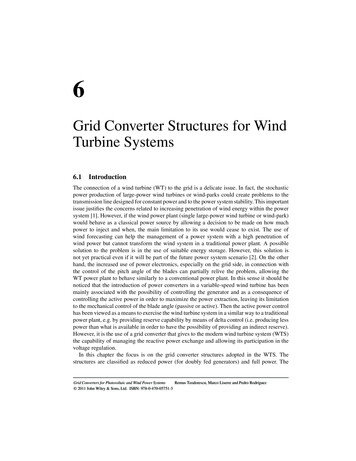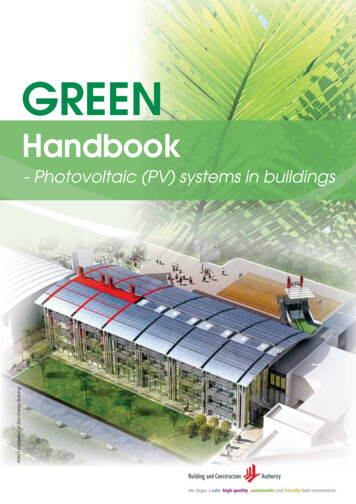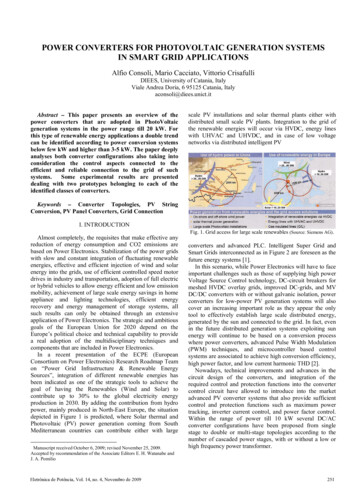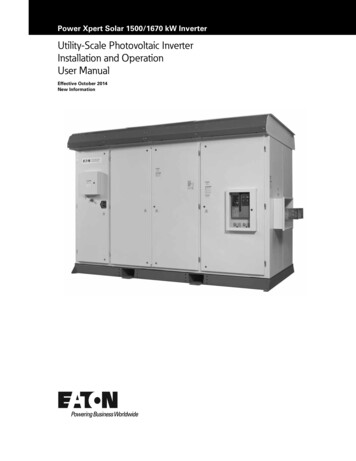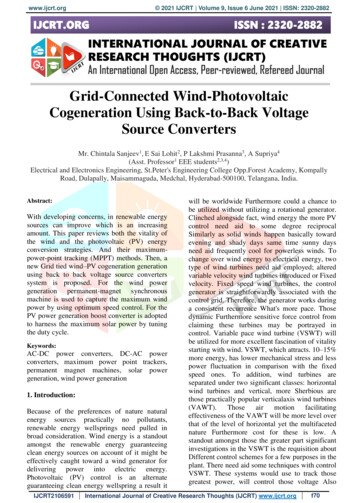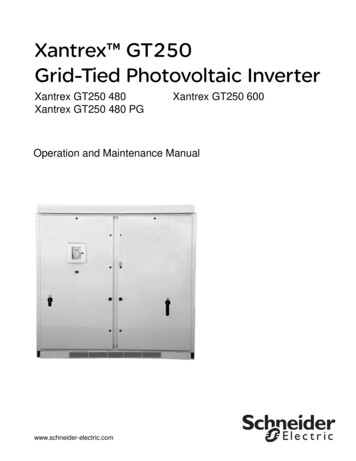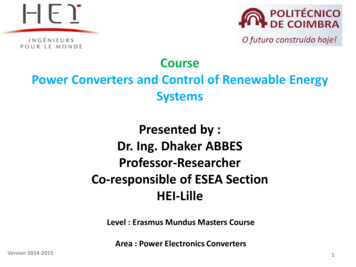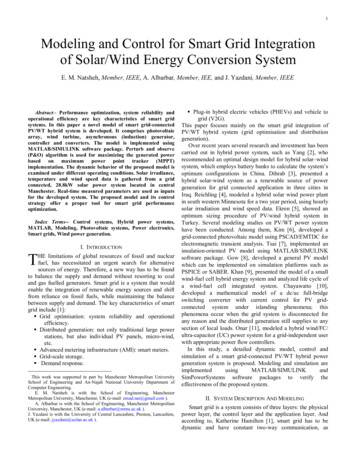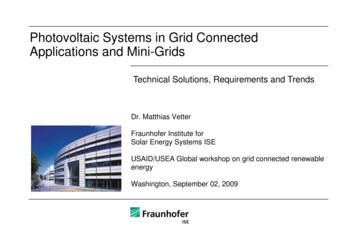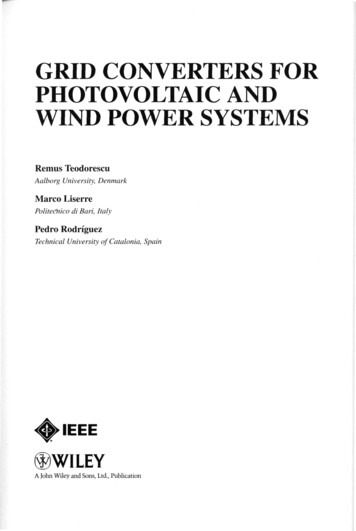
Transcription
GRID CONVERTERS FORPHOTOVOLTAIC ANDWIND POWER SYSTEMSRemus TeodorescuAalborg University, DenmarkMarco LiserrePoliteCnico di Bari, ItalyPedro RodriguezTechnical University of Catalonia, Spain ф 1ЕЕЕ WILEYA John Wiley and Sons, Ltd., Publication
ContentsAbout the 2.42.52.62.7IntroductionWind Power DevelopmentPhotovoltaic Power DevelopmentThe Grid Converter - The Key Element in Grid Integrationof WT and PV SystemsReferencesPhotovoltaic Inverter StructuresIntroductionInverter Structures Derived from H-Bridge Topology2.2.1Basic Full-Bridge Inverter2.2.2H5 Inverter (SMA)2.2.3HERIC Inverter (Sunways)2.2.4REFU Inverter2.2.5Full-Bridge Inverter with DC Bypass - FB-DCBP (Ingeteam)2.2.6Full-Bridge Zero Voltage Rectifier - FB-ZVR2.2.7Summary of H-Bridge Derived TopologiesInverter Structures Derived from NPC Topology2.3.1Neutral Point Clamped (NPC) Half-Bridge Inverter2.3.2Conergy NPC Inverter2.3.3Summary of NPC-Derived Inverter TopologiesTypical PV Inverter Structures2.4.1H-Bridge Based Boosting PV Inverter with High-FrequencyTransformerThree-Phase PV InvertersControl StructuresConclusions and Future 12325252526272829
755.15.2Grid Requirements for PVIntroductionInternational Regulations3.2.1IEEE 1547 Interconnection of Distributed Generation3.2.2IEC 61727 Characteristics of Utility Interface3.2.3VDE 0126-1-1 Safety3.2.4IEC 61000 Electromagnetic Compatibility (EMC - low frequency)3.2.5EN 50160 Public Distribution Voltage QualityResponse to Abnormal Grid Conditions3.3.1Voltage Deviations3.3.2Frequency Deviations3.3.3Reconnection after TripPower Quality3.4.1DC Current Injection3.4.2Current Harmonics3.4.3Average Power FactorAnti-islanding Requirements3.5.1AI Defined by IEEE 1547/UL 17413.5.2AI Defined by IEC 621163.5.3AI Defined by VDE 7373738383940404141Grid Synchronization in Single-Phase Power ConvertersIntroductionGrid Synchronization Techniques for Single-Phase Systems4.2.1Grid Synchronization Using the Fourier Analysis4.2.2Grid Synchronization Using a Phase-Locked LoopPhase Detection Based on In-Quadrature SignalsSome PLLs Based on In-Quadrature Signal Generation4.4.1PLL Based on a T/4 Transport Delay4.4.2PLL Based on the Hubert Transform4.4.3PLL Based on the Inverse Park TransformSome PLLs Based on Adaptive Filtering4.5.1The Enhanced PLL4.5.2Second-Order Adaptive Filter4.5.3Second-Order Generalized Integrator4.5.4The SOGI-PLLThe SOGI Frequency-Locked Loop4.6.1Analysis of the 2747880828989Islanding DetectionIntroductionNondetection Zone939394
.5viiOverview of Islanding Detection MethodsPassive Islanding Detection Methods5.4.1OUF-OUVDetection5.4.2Phase Jump Detection (PJD)5.4.3Harmonic Detection (HD)5.4.4Passive Method EvaluationActive Islanding Detection Methods5.5.1Frequency Drift Methods5.5.2Voltage Drift Methods5.5.3Grid Impedance Estimation5.5.4PLL-Based Islanding Detention5.5.5Comparison of Active Islanding Detection 14119121121Grid Converter Structures for Wind Turbine SystemsIntroductionWTS Power ConfigurationsGrid Power Converter Topologies6.3.1Single-Cell (VSC or CSC)6.3.2Multicell (Interleaved or Cascaded)WTS Control6.4.1Generator-Side Control6.4.2WTS Grid 9142142Grid Requirements for WT SystemsIntroductionGrid Code 7.2.5Ireland7.2.6USChina7.2.7Summary7.2.8Frequency and Voltage Deviation under Normal OperationActive Power Control in Normal OperationPower Curtailment7.4.17.4.2Frequency ControlReactive Power Control in Normal 46148148149149150150150151151152153154155155157157
nts7.5.4UK7.5.5Ireland7.5.6USBehaviour under Grid ussion of Harmonization of Grid CodesFuture Trends7.8.1Local Voltage Control7.8.2Inertia Emulation (IE)7.8.3Power Oscillation Dumping 65165166166167Grid Synchronization in Three-Phase Power ConvertersIntroductionThe Three-Phase Voltage Vector under Grid Faults8.2.1Unbalanced Grid Voltages during a Grid Fault8.2.2Transient Grid Faults, the Voltage Sags (Dips)8.2.3Propagation of Voltage SagsThe Synchronous Reference Frame PLL under Unbalanced and DistortedGrid ConditionsThe Decoupled Double Synchronous ReferenceFrame PLL (DDSRF-PLL)8.4.1The Double Synchronous Reference Frame8.4.2The Decoupling Network8.4.3Analysis of the DDSRF8.4.4Structure and Response of the DDSRF-PLLThe Double Second-Order Generalized Integrator FLL (DSOGI-FLL)8.5.1Structure of the DSOGI8.5.2Relationship between the DSOGI and the DDSRF8.5.3The FLL for the DSOGI8.5.4Response of the 187189192194197198200200201203Grid Converter Control for WTSIntroductionModel of the Converter9.2.1Mathematical Model of the L-Filter Inverter9.2.2Mathematical Model of the LCL-Filter InverterAC Voltage and DC Voltage Control9.3.1Management of the DC Link Voltage9.3.2Cascaded Control of the DC Voltage through the AC Current205205206207209210211213182
1.211.311.411.5ix9.3.3Tuning Procedure of the PI Controller9.3.4PI-Based Voltage Control Design ExampleVoltage Oriented Control and Direct Power Control9.4.1Synchronous Frame VOC: PQ Open-Loop Control9.4.2Synchronous Frame VOC: PQ Closed-Loop Control9.4.3Stationary Frame VOC: PQ Open-Loop Control9.4.4Stationary Frame VOC: PQ Closed-Loop Control9.4.5Virtual-Flux-Based Control9.4.6Direct Power ControlStand-alone, Micro-grid, Droop Control and Grid Supporting9.5.1Grid-Connected/Stand-Alone Operation without Load Sharing9.5.2Micro-Grid Operation with Controlled Storage9.5.3Droop b228229229231234235Control of Grid Converters under Grid FaultsIntroductionOverview of Control Techniques for Grid-Connected Converters underUnbalanced Grid Voltage ConditionsControl Structures for Unbalanced Current Injection10.3.1Decoupled Double Synchronous Reference Frame CurrentControllers for Unbalanced Current Injection10.3.2Resonant Controllers for Unbalanced Current InjectionPower Control under Unbalanced Grid Conditions10.4.1Instantaneous Active-Reactive Control (IARC)10.4.2Positive-and Negative-Sequence Control (PNSC)10.4.3Average Active-Reactive Control (AARC)10.4.4Balanced Positive-Sequence Control (BPSC)10.4.5Performance of the IARC, PNSC, AARC and BPSC Strategies10.4.6Flexible Positive- and Negative-Sequence Control (FPNSC)Flexible Power Control with Current Limitation10.5.1Locus of the Current Vector under Unbalanced Grid Conditions10.5.2Instantaneous Value of the Three-Phase Currents10.5.3Estimation of the Maximum Current in Each Phase10.5.4Estimation of the Maximum Active and Reactive Power Set-Point70.5.5Performance of the 64267269270272274277279285285Grid Filter DesignIntroductionFilter TopologiesDesign ConsiderationsPractical Examples of LCL Filters and Grid InteractionsResonance Problem and Damping Solutions289289290291296300238244
5.1Instability of the Undamped Current Control Loop11.5.2Passive Damping of the Current Control Loop11.5.3Active Damping of the Current Control LoopNonlinear Behaviour of the FilterSummaryReferences300302304306311311Grid Current ControlIntroductionCurrent Harmonic RequirementsLinear Current Control with Separated Modulation12.3.1Use of Averaging12.3.2Pi-Based Control12.3.3Deadbeat Control12.3.4Resonant Control12.3.5Harmonic CompensationModulation 3Multilevel Modulations12.4.4Interleaved ModulationOperating Limits of the Current-Controlled ConverterPractical 9335338340343347347350353353Appendix ASpace Vector Transformations of Three-Phase SystemsA. 1IntroductionA.2Symmetrical Components in the Frequency DomainA.3Symmetrical Components in the Time DomainA.4Components a/30 on the Stationary Reference FrameA.5Components dqO on the Synchronous Reference FrameReferences355355355357359361362Appendix ВInstantaneous Power TheoriesB.lIntroductionB.2Origin of Power Definitions at the Time Domain forSingle-Phase SystemsB.3Origin of Active Currents in Multiphase SystemsB.4Instantaneous Calculation of Power Currents inMultiphase SystemsB.5The p-q TheoryB.6Generalization of the p-q Theory to Arbitrary Multiphase SystemsB.7The Modified p-q TheoryB.8Generalized Instantaneous Reactive Power Theory for Three-PhasePower Systems363363365366369371373374376
ContentsB.9xiSummaryReferences377378Appendix СResonant ControllerC.lIntroductionC.2Internal Model PrincipleC.3Equivalence of the PI Controller in the dq Frame and the P ResonantController in the aß Frame381381381Index385382
1.1 Wind Power Development 1 1.2 Photovoltaic Power Development 3 1.3 The Grid Converter - The Key Element in Grid Integration of WT and PV Systems 4 References 4 2 Photovoltaic Inverter Structures 5 2.1 Introduction 5 2.2 Inverter Structures Derived from H-Bridge Topology 6 2.2.1 Basic Full-Bridge Inverter 7 2.2.2 H5 Inverter (SMA) 11
